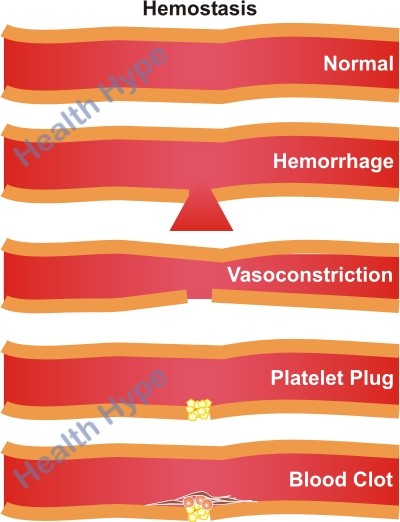Excessive Bleeding – Different Types of Bleeding Disorders
The body has an efficient mechanism for stopping blood loss when bleeding arises. This mechanism has several phases to first reduce the degree of bleeding, temporarily plug the point of the blood loss, further seal the area for the long term and then expedite healing of the affected blood vessel to restore its integrity. The entire process is carefully coordinated by the body to ensure that the sequence of events will stop the blood loss as rapidly as possible. In some instances where there is a severe injury with excessive blood loss, these mechanisms are ineffective and medical attention is necessary. This is usually when the tear or rupture of the blood vessel is so severe that physical measures are needed to preserve life until medical attention can be sought. At other times, a person with bleeding disorder may find that even a minor cut can lead to excessive blood loss.
What are bleeding disorders?
A bleeding disorder is any impairment in the process of hemostasis (mechanism to prevent blood loss) thereby leading to profuse and/or prolonged bleeding. Most of these bleeding disorders involve one or more defects in the phases or components of hemostasis.
There are four distinct phases in hemostasis which is geared to stop blood loss.
- First the damaged blood vessel narrows (vasoconstriction) to reduce the blood flow and therefore blood loss. This happens almost immediately once the blood vessel is damaged.
- Second the platelets in the blood (small particles of larger cells) adheres to the lining of the damaged blood vessel and stick to each other to plug the site of blood loss (platelet plug). This is known as the platelet phase and occurs within seconds of a tear in the blood vessel.
- Then the various clotting factors activate each other (coagulation cascade) to turn the liquid blood components into a more semi-solid to solid mass (blood clot). This is the clotting phase or coagulation phase. The clot also retracts to draw the damaged ends of the blood vessel together and form a tight seal and this is sometimes mentioned as separate phase known as clot retraction.
- The last phase involves the removal of the clot once the blood vessel is completely repaired. The clot may be dissolved (fibrinolysis) or sometimes contributes to scar formation at the site (fibrosis).
The focus is often on the clotting phase which is a complex multi-step process involving several factors. Due to the complexity of this phase and participating components, it is open to a number of defects and disturbances. However, some bleeding disorders may also involve the platelets, carrier proteins and blood vessel abnormalities. Most of these disorders are inherited and present from birth (congenital) although some may be acquired in life and arise secondary to a pre-existing disease.
Types of Bleeding Disorders
The two most common bleeding disorders in von Willebrand disease and hemophilia.
von Willebrand disease (vWD) is a deficiency or defect of von Willebrand factor (vWF) which is an important carrier of clotting factor VIII and helps platelets adhere to the site of the blood vessel damage. The different types of von Willebrand disease include :
- Type 1 where there is a partial deficiency of von Willebrand factor.
- Type 2 where there is a defect in von Willebrand factor.
- Type 3 where there is an almost complete deficiency of von Willebran factor.
Hemophilia is a deficiency of one of the clotting factors involved in the coagulation cascade that eventually leads to the formation of a blood clot. Hemophilia A and B mainly affects males. There are three different types :
- Hemophilia A where there is a deficiency in factor VII
- Hemophilia B where there is a deficiency in factor IX
- Hemophilia C where there is a deficiency in factor XI
Thrombocytopenia purpura (TP) is due to a deficiency of circulating platelets, the cell particles that are essential for the formation of a platelet plug and contribute to blood clotting.
Vitamin K deficiency causes a mild bleeding disorder due to a deficiency of clotting factors VII, IX, X and prothrombin (factor II). The liver utilizes vitamin K to synthesize these clotting factors.
Factor I deficiency is due to a lack (afibrinogenemia), deficiency (hypofibrinogenemia) or defective functioning (dysfibrinogenemia) of fibrinogen.
Blood vessel wall abnormalities where there is a weakening of the wall which will easily tear or rupture. These conditions are rare and includes :
- Hereditary hemorrhagic telangiectasia
- Ehlers-Danlos disease
- Scurvy
Signs and Symptoms Bleeding Disorder
Most bleeding disorders have the same clinical presentation, the extent of which depends on the type of bleeding disorder and severity.
Easy bruising and profuse bleeding when injured are the main signs. In milder bleeding disorders, this may only be seen with severe falls and bumps or upon surgery and dental procedures. In severe bleeding disorders, bruising may arise spontaneously even without any obvious injury and even small cuts may lead to profuse bleeding.
Women may report prolonged or heavy menses. Recurrent and prolonged nosebleeds, bleeding in the gut which leads to blood in the stool, blood in the urine and bleeding gums are other characteristics signs of bleeding disorders. Depending on the extent of blood loss, patients may exhibit signs of anemia such as paleness, breathlessness, easily fatigued upon even slightest physical activity and constantly tired.





